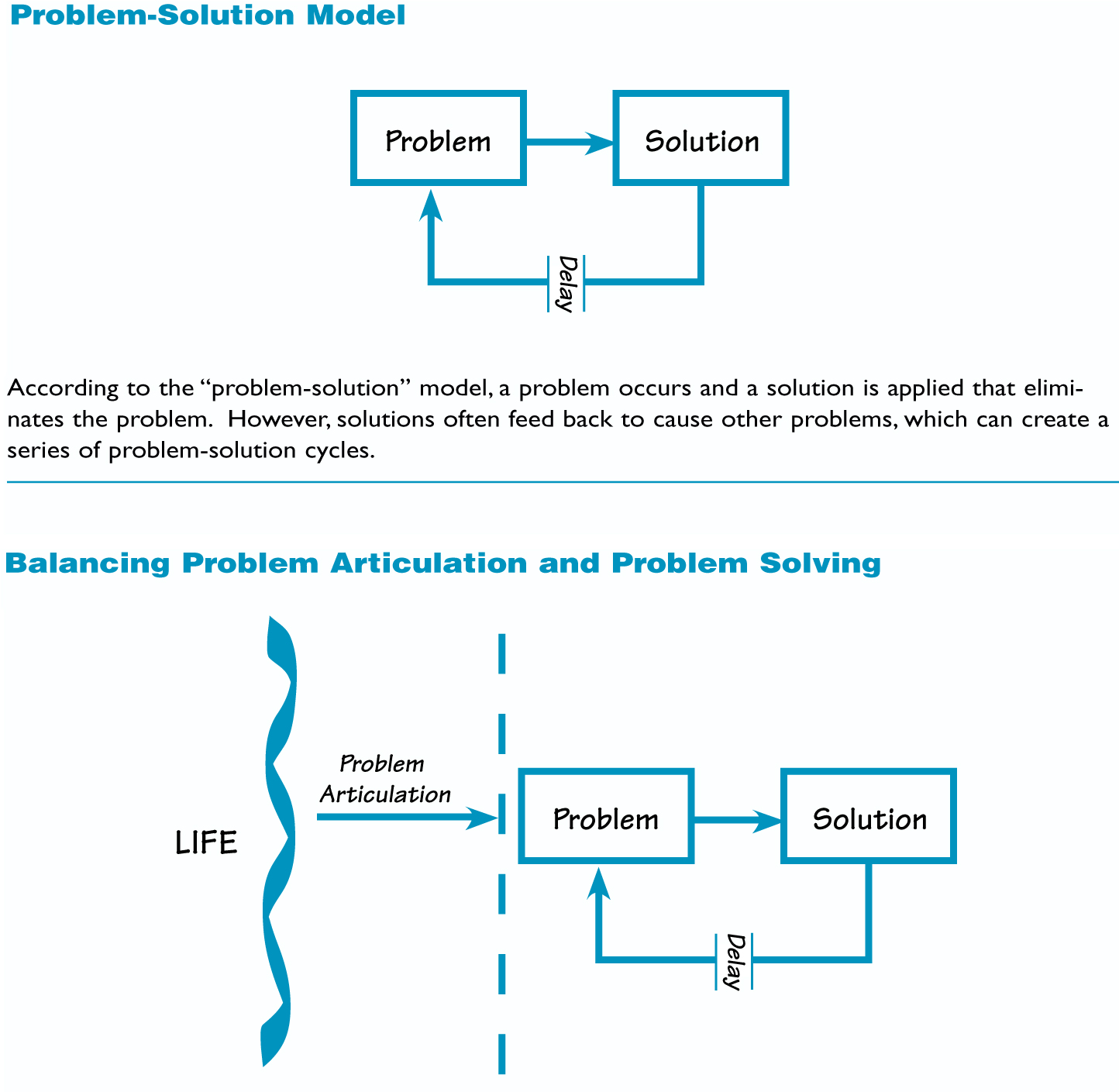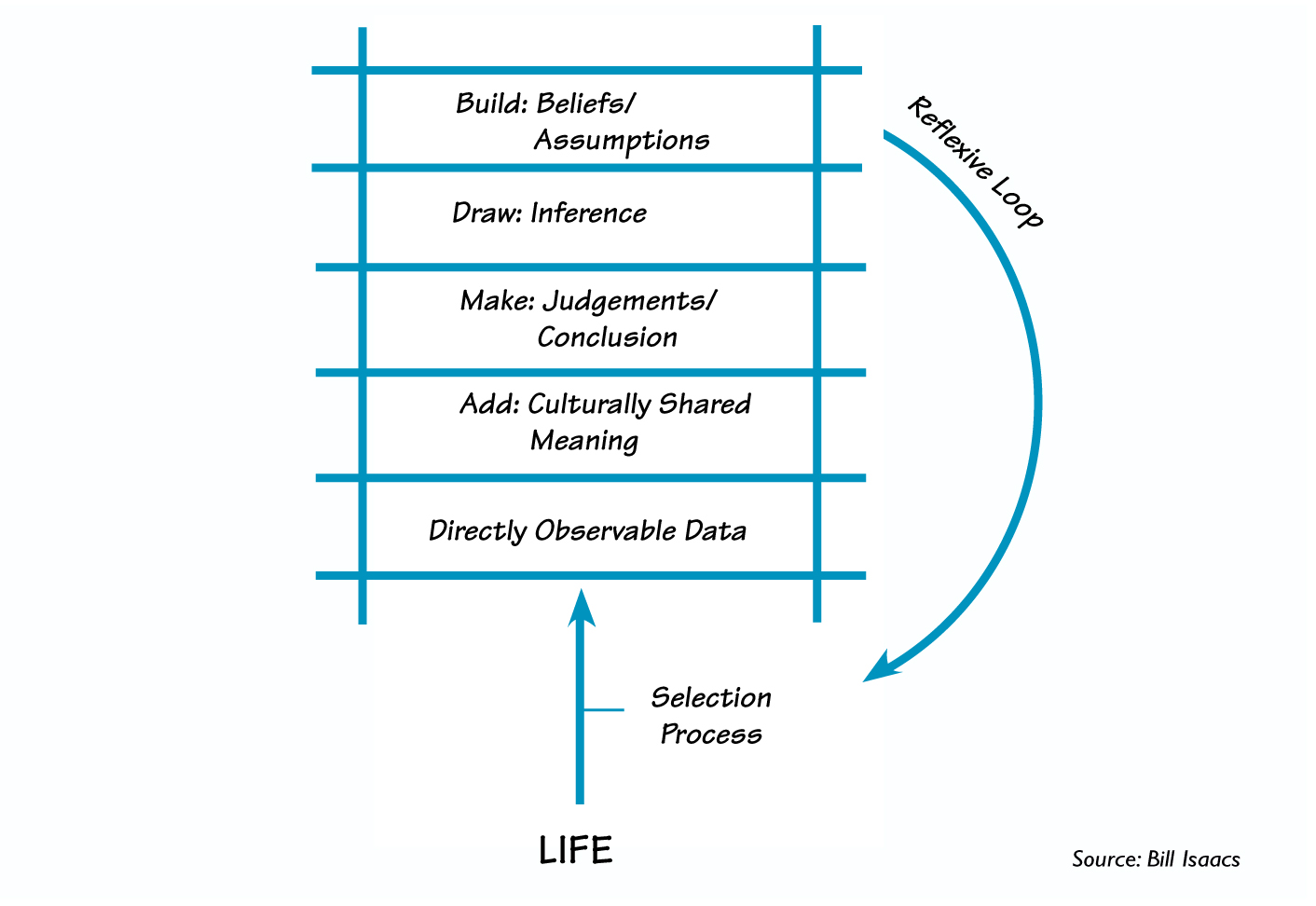We are in the midst of an unprecedented upheaval — a fundamental shift in the structure and nature of business. According to Fortune magazine, “The greatest social convulsions of the years ahead may occur in the workplace, as companies struggling with fast-paced change and brutal competition reshape themselves — and redefine what it means to hold a job” (“A Brave New Darwinian Workplace,” Jan. 25, 1993).
To respond to this changing paradigm, what is needed may not be a change of action, but a change in perception. How we think, act, and value are all associated with our particular view of reality. In order to create a new “reality,” we must discover how our current worldview affects the way we perceive and respond to problems. The leverage lies in going to a more fundamental level — to look beyond the problems themselves and re-examine the paradigm that gave rise to them.
The Problem-Solving Model of Managing
The prevailing model of management can be described as a “problem-solution” model: we encounter problems, and as managers, we are expected to solve them as quickly as possible (see “Problem-Solution Model”). In this model, we attack each problem individually, apply an appropriate solution, and then move on to the next one. The problems rarely remain “solved,” however. From a systems thinking perspective, we can see how solutions often feedback to create other problems, or even a repeat of the same problem. By the time this happens, it often appears to be a brand new problem because we either have forgotten about the previous round of solutions, or the same person is no longer in that position (the average tenure in a position is 18 months or less in some companies). This creates a series of problem-solution cycles that can keep an organization continually busy fighting fires instead of taking more fundamental action.
How we think, act, and value are all associated with our particular view of reality. In order to adapt to and create a new “reality,” we must discover how our current worldview affects the way we perceive and respond to problems.
At its worst, the problem-solution paradigm leads us to see problems in terms of pre-determined solutions. Statements such as, “The problem is we need a better information system,” or “The problem is we need the latest flexible manufacturing system,” are examples of solution statements at work. The danger of this habit is that once we begin to frame problems in terms of solution statements, we exclude other possibilities — including the possibility that our original statement of the problem may be wrong.
Even when we don’t resort to our favorite solution, we often don’t challenge the problem statement itself. Problems are nothing more than a formal statement of a set of assumptions about the world. Those assumptions, however, are often not made explicit. By conversing and making decisions at the level of tacit assumptions, we can get very good at defending our point of view at the expense of learning. This can lead to what Chris Argyris of Harvard University calls “skilled incompetence.” Rather than looking at the real data and real issues — which may prompt a re-articulation of the problem — we become very skilled at dancing around the issues.
Problem Articulation
To re-examine the way we think about problems and solutions, we need to understand more fundamentally what a problem is. In reality, there are no problems “out there” in the world — nature just is. Whether we see an event or situation as a problem depends on our view of the world. For example, if oil prices double, is that a problem? Our response would be a resounding “Yes!” since our economy is heavily dependent on petroleum products. If we lived in an OPEC nation, however, we would not see it as a problem at all. If we lived in an undeveloped country with no dependence on oil, we probably would not even be interested.
PROBLEM ARTICULATION

To an extent, we create the problems we see by the way we view reality, and how we articulate those problems can determine the future direction of our reality. To break out of the “problem-solution” model of reality, we need to go back one step further to re-examine the question,“How did we distill out of this vast pool of life a particular problem which led us to act a certain way?”
Problems do not exist independently of the person who sees them Out of the pool of life we “construct” problems in our minds (or in our organizations) by the way we view reality (see “Problem Articulation”). Fred Kofman of the M.I.T. Sloan School of Management suggests that deconstructing a problem and finding a way to re-articulate it can provide much more leverage than trying to just double our efforts to solve the problem as it is currently stated. One of the clear challenges is to explore more explicitly how we articulate problems. Why do we consider something a problem? The “why” is what leads us to surface the deeper set of assumptions that may give insight into reformulating an entirely different problem.
Paradigm-Creating Loops
How can we break out of the problem-solving straitjacket and begin reframing issues in new ways? One tool that can help is the “Ladder of Inference,” developed by Chris Argyris. The “Ladder of Inference” provides a framework for exploring mental models. It graphically depicts the process we use to draw conclusive opinions and judgments from data, showing that individual evaluations are, in reality, highly abstract and inferential.
At the bottom of the “Ladder of Inference” is directly observable data: those things that can be objectively observed (see “The Reflexive Loop”). From that data, we add culturally shared meaning — that is, we interpret and make sense of an event by the norms of our culture. For example, suppose Bob, a colleague, walked into a 9:00 meeting at 9:15. The directly observable data is that Bob physically entered the room 15 minutes after the scheduled start time. What do we say to ourselves when we notice this?
When managers are asked this question, typical responses are:
“He’s late.” “He doesn’t care.” “His previous meeting ran late.” “He’s not a team player.” “He’s disorganized.”
If we locate the responses on the “Ladder of Inference,” we see that most of them are on the higher rungs of the ladder, reflecting judgments and values based on the observable data.
There is nothing inherently wrong about drawing inferences and conclusions from the events we observe. In fact, the ability to move quickly up the ladder is what enables us to make sense of the incredibly complex, infinitely detailed world in which we live. It is impossible for us to see and absorb everything — we are constantly selecting out a narrow slice of life to focus on and understand. What we don’t often realize, however, is that our set of beliefs and assumptions directly affect the selection process by which we receive new observable data. Argyris calls this process the reflexive loop because it happens subconsciously and involuntarily.
For example, if we have concluded that Bob doesn’t really care about meetings and is not a team player, what do we begin to notice about Bob? We take note of all the times he shows up late and we ignore or aren’t aware of all the times he is on time. We notice that Bob does not say much at meetings, but don’t register the fact that a few people always dominate the conversation and that there are others who say even less than Bob. We continually filter out any information that doesn’t fit in with the mental model we have created about Bob. In fact, all the data we see confirm our beliefs and assumptions about Bob. We have leaped from data up to beliefs and assumptions, and then operated as if the assumptions are the reality.
The reflexive loop can also be called the paradigm-creating loop, because it is the process through which, over time, we develop a shared set of corporate assumptions and beliefs about reality. In The Machine That Changed The World (New York: Rawson Associates), there is a striking example of how this paradigm-creating process literally affects our ability to see. The book describes a new system of manufacturing invented by Toyota called “lean production” that uses less material, requires smaller inventories, has a shorter design time, and produces fewer defects than the traditional mass production system (See “Lean Production: From the Machine Age to the Systems Age,” August 1991). The authors tell the story of a General Motors plant manager’s reaction after seeing a lean production plant in Japan: He “reported that secret repair areas and secret inventories had to exist behind the plant, because he hadn’t seen enough of either for a ‘real’ plant.” In actuality, there is no rework area in that plant — they drive the cars right off the assembly line and onto the ships. The GM manager’s paradigm of a “real” plant kept him from seeing that there might be an alternative way to produce cars.
Mistaking the Map for the Territory
Comedian Steven Wright tells this joke: “Last summer my wife and I were planning our summer vacation. We bought a map of the United States. It was life-sized. One mile equals one mile. We never went on the vacation because it took the whole summer to fold the map.”
Of course, buying a life-sized map is ridiculous — it would be no more useful than reality itself. A map is useful precisely because it is a simplification of reality. We would never mistake the map for the territory and plan a trip as if California is only three feet away from New York. And yet we are prone to make such errors of perception whenever we mistake our mental models for the real world.
Marcel Proust once said,“The real voyage of discovery consists not in seeking new landscapes but in having new eyes.” Becoming aware of how our view of the world is continually being constructed through the reflexive loop can prevent us from mistaking the map for the territory. Seeing problems as a product of our own thinking and not a product of nature can open our eyes to a whole new world of possibilities.
THE REFLEXIVE LOOP

The reflexive loop illustrates how our mental models can influence the way we view reality. We make leaps up the “Ladder of Inference” from data to values and assumptions, and then operate based on those assumptions as if they are reality. It can also be called the paradigm-creating loop, because it is the process through which, over time, we develop a shared set of cultural assumptions and values about how we view reality.
